Behnood Rasti
HZDR
Continual Self-Supervised Learning with Masked Autoencoders in Remote Sensing
Jun 26, 2025Abstract:The development of continual learning (CL) methods, which aim to learn new tasks in a sequential manner from the training data acquired continuously, has gained great attention in remote sensing (RS). The existing CL methods in RS, while learning new tasks, enhance robustness towards catastrophic forgetting. This is achieved by using a large number of labeled training samples, which is costly and not always feasible to gather in RS. To address this problem, we propose a novel continual self-supervised learning method in the context of masked autoencoders (denoted as CoSMAE). The proposed CoSMAE consists of two components: i) data mixup; and ii) model mixup knowledge distillation. Data mixup is associated with retaining information on previous data distributions by interpolating images from the current task with those from the previous tasks. Model mixup knowledge distillation is associated with distilling knowledge from past models and the current model simultaneously by interpolating their model weights to form a teacher for the knowledge distillation. The two components complement each other to regularize the MAE at the data and model levels to facilitate better generalization across tasks and reduce the risk of catastrophic forgetting. Experimental results show that CoSMAE achieves significant improvements of up to 4.94% over state-of-the-art CL methods applied to MAE. Our code is publicly available at: https://git.tu-berlin.de/rsim/CoSMAE.
A Plasticity-Aware Method for Continual Self-Supervised Learning in Remote Sensing
Mar 31, 2025Abstract:Continual self-supervised learning (CSSL) methods have gained increasing attention in remote sensing (RS) due to their capability to learn new tasks sequentially from continuous streams of unlabeled data. Existing CSSL methods, while learning new tasks, focus on preventing catastrophic forgetting. To this end, most of them use regularization strategies to retain knowledge of previous tasks. This reduces the model's ability to adapt to the data of new tasks (i.e., learning plasticity), which can degrade performance. To address this problem, in this paper, we propose a novel CSSL method that aims to learn tasks sequentially, while achieving high learning plasticity. To this end, the proposed method uses a knowledge distillation strategy with an integrated decoupling mechanism. The decoupling is achieved by first dividing the feature dimensions into task-common and task-specific parts. Then, the task-common features are forced to be correlated to ensure memory stability while the task-specific features are forced to be de-correlated facilitating the learning of new features. Experimental results show the effectiveness of the proposed method compared to CaSSLe, which is a widely used CSSL framework, with improvements of up to 1.12% in average accuracy and 2.33% in intransigence in a task-incremental scenario, and 1.24% in average accuracy and 2.01% in intransigence in a class-incremental scenario.
HyCoT: Hyperspectral Compression Transformer with an Efficient Training Strategy
Aug 16, 2024
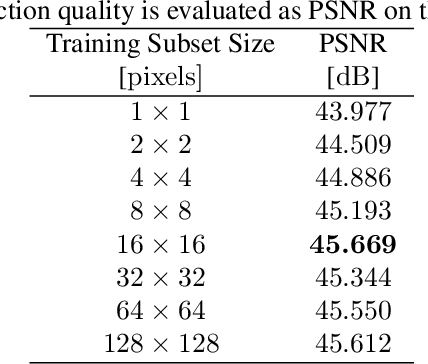
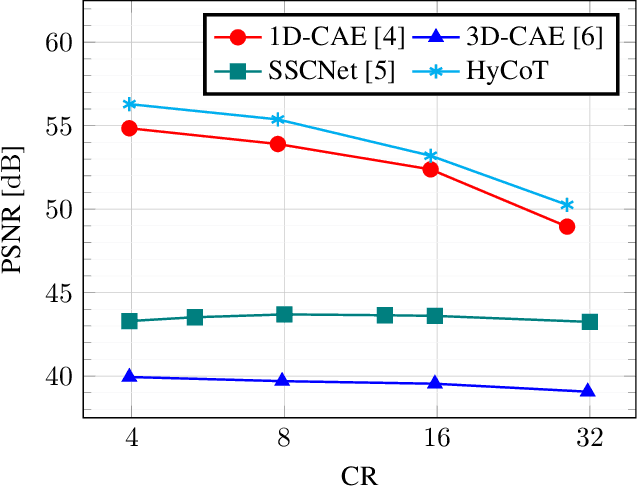
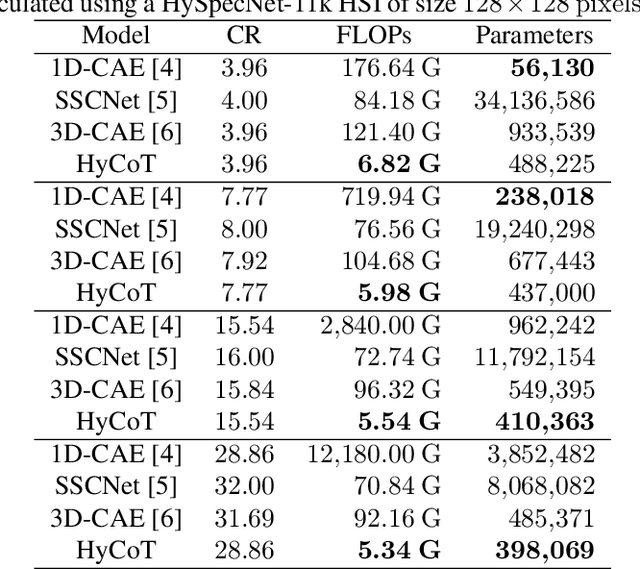
Abstract:The development of learning-based hyperspectral image (HSI) compression models has recently attracted significant interest. Existing models predominantly utilize convolutional filters, which capture only local dependencies. Furthermore, they often incur high training costs and exhibit substantial computational complexity. To address these limitations, in this paper we propose Hyperspectral Compression Transformer (HyCoT) that is a transformer-based autoencoder for pixelwise HSI compression. Additionally, we introduce an efficient training strategy to accelerate the training process. Experimental results on the HySpecNet-11k dataset demonstrate that HyCoT surpasses the state-of-the-art across various compression ratios by over 1 dB with significantly reduced computational requirements. Our code and pre-trained weights are publicly available at https://git.tu-berlin.de/rsim/hycot .
Fast Semi-supervised Unmixing using Non-convex Optimization
Jan 23, 2024Abstract:In this paper, we introduce a novel linear model tailored for semisupervised/library-based unmixing. Our model incorporates considerations for library mismatch while enabling the enforcement of the abundance sum-to-one constraint (ASC). Unlike conventional sparse unmixing methods, this model involves nonconvex optimization, presenting significant computational challenges. We demonstrate the efficacy of Alternating Methods of Multipliers (ADMM) in cyclically solving these intricate problems. We propose two semisupervised unmixing approaches, each relying on distinct priors applied to the new model in addition to the ASC: sparsity prior and convexity constraint. Our experimental results validate that enforcing the convexity constraint outperforms the sparsity prior for the endmember library. These results are corroborated across three simulated datasets (accounting for spectral variability and varying pixel purity levels) and the Cuprite dataset. Additionally, our comparison with conventional sparse unmixing methods showcases considerable advantages of our proposed model, which entails nonconvex optimization. Notably, our implementations of the proposed algorithms-fast semisupervised unmixing (FaSUn) and sparse unmixing using soft-shrinkage (SUnS)-prove considerably more efficient than traditional sparse unmixing methods. SUnS and FaSUn were implemented using PyTorch and provided in a dedicated Python package called Fast Semisupervised Unmixing (FUnmix), which is open-source and available at https://github.com/BehnoodRasti/FUnmix
PCB-Vision: A Multiscene RGB-Hyperspectral Benchmark Dataset of Printed Circuit Boards
Jan 12, 2024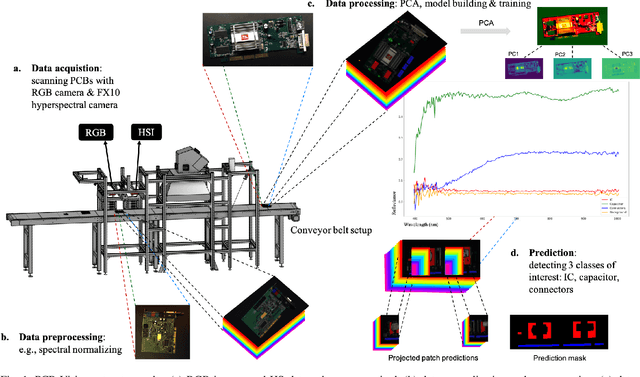
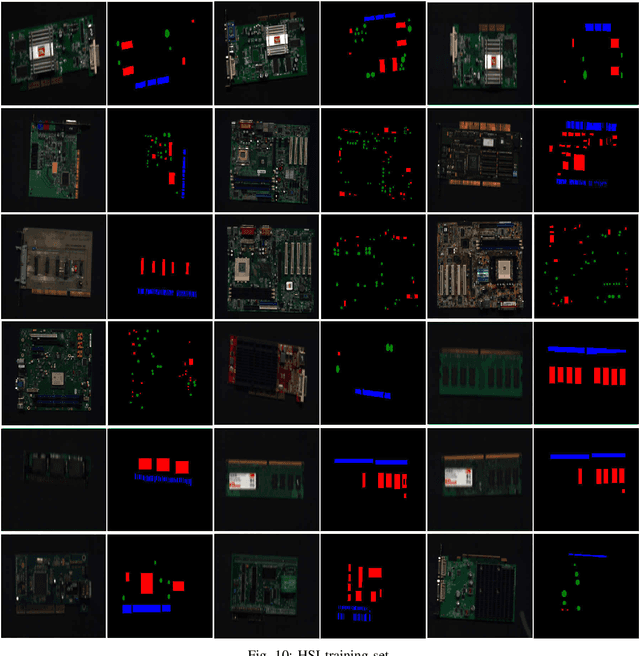
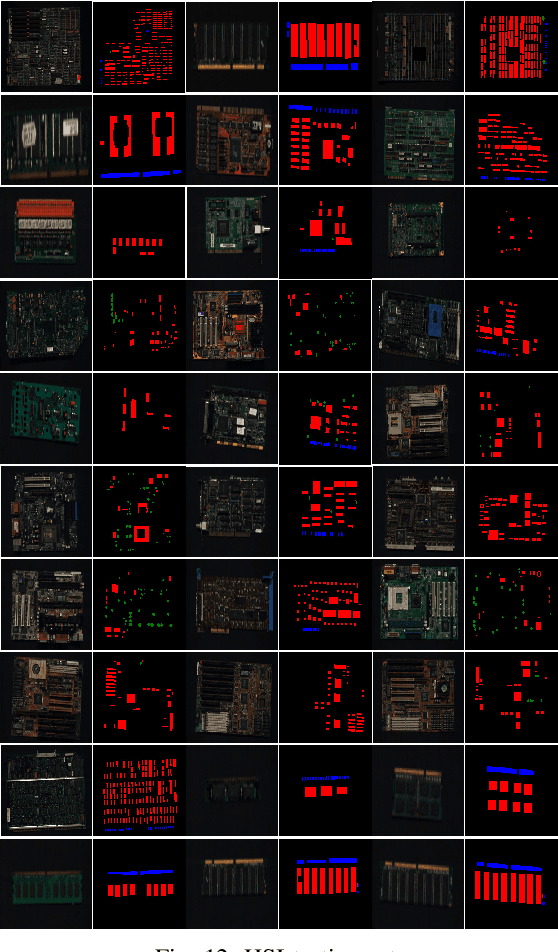
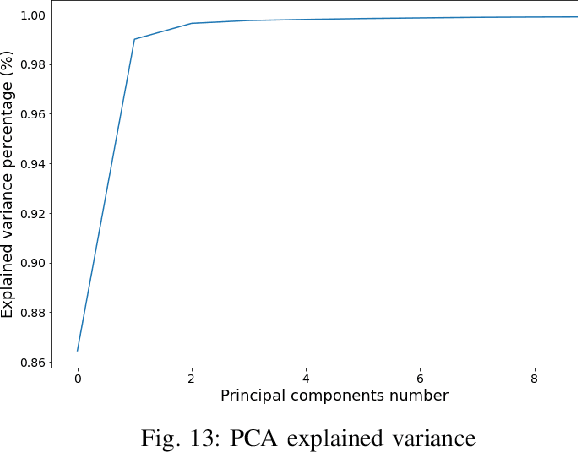
Abstract:Addressing the critical theme of recycling electronic waste (E-waste), this contribution is dedicated to developing advanced automated data processing pipelines as a basis for decision-making and process control. Aligning with the broader goals of the circular economy and the United Nations (UN) Sustainable Development Goals (SDG), our work leverages non-invasive analysis methods utilizing RGB and hyperspectral imaging data to provide both quantitative and qualitative insights into the E-waste stream composition for optimizing recycling efficiency. In this paper, we introduce 'PCB-Vision'; a pioneering RGB-hyperspectral printed circuit board (PCB) benchmark dataset, comprising 53 RGB images of high spatial resolution paired with their corresponding high spectral resolution hyperspectral data cubes in the visible and near-infrared (VNIR) range. Grounded in open science principles, our dataset provides a comprehensive resource for researchers through high-quality ground truths, focusing on three primary PCB components: integrated circuits (IC), capacitors, and connectors. We provide extensive statistical investigations on the proposed dataset together with the performance of several state-of-the-art (SOTA) models, including U-Net, Attention U-Net, Residual U-Net, LinkNet, and DeepLabv3+. By openly sharing this multi-scene benchmark dataset along with the baseline codes, we hope to foster transparent, traceable, and comparable developments of advanced data processing across various scientific communities, including, but not limited to, computer vision and remote sensing. Emphasizing our commitment to supporting a collaborative and inclusive scientific community, all materials, including code, data, ground truth, and masks, will be accessible at https://github.com/hifexplo/PCBVision.
Masking Hyperspectral Imaging Data with Pretrained Models
Nov 06, 2023



Abstract:The presence of undesired background areas associated with potential noise and unknown spectral characteristics degrades the performance of hyperspectral data processing. Masking out unwanted regions is key to addressing this issue. Processing only regions of interest yields notable improvements in terms of computational costs, required memory, and overall performance. The proposed processing pipeline encompasses two fundamental parts: regions of interest mask generation, followed by the application of hyperspectral data processing techniques solely on the newly masked hyperspectral cube. The novelty of our work lies in the methodology adopted for the preliminary image segmentation. We employ the Segment Anything Model (SAM) to extract all objects within the dataset, and subsequently refine the segments with a zero-shot Grounding Dino object detector, followed by intersection and exclusion filtering steps, without the need for fine-tuning or retraining. To illustrate the efficacy of the masking procedure, the proposed method is deployed on three challenging applications scenarios that demand accurate masking; shredded plastics characterization, drill core scanning, and litter monitoring. The numerical evaluation of the proposed masking method on the three applications is provided along with the used hyperparameters. The scripts for the method will be available at https://github.com/hifexplo/Masking.
A Multisensor Hyperspectral Benchmark Dataset For Unmixing of Intimate Mixtures
Aug 30, 2023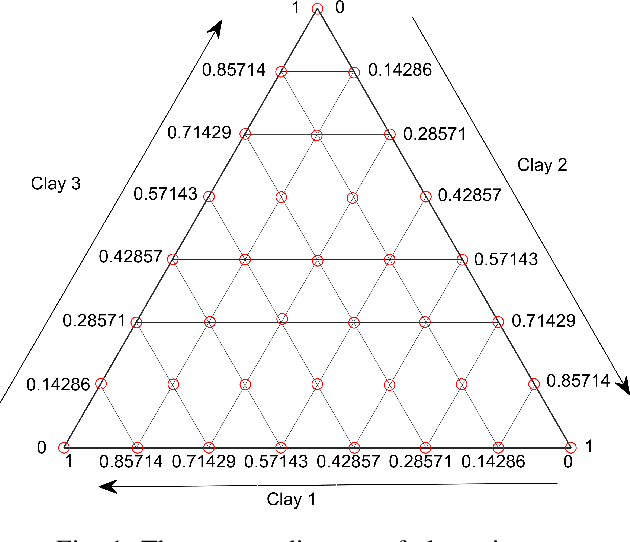
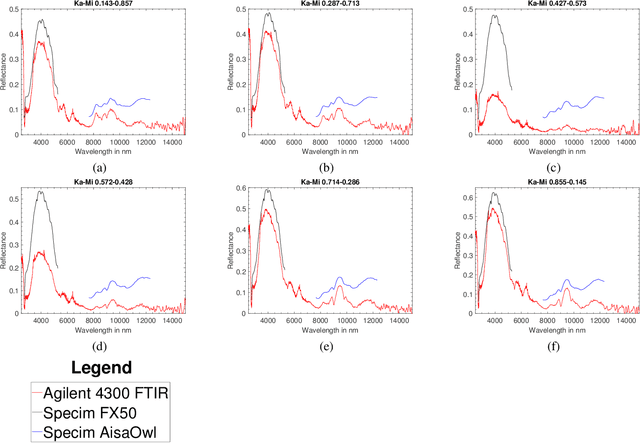
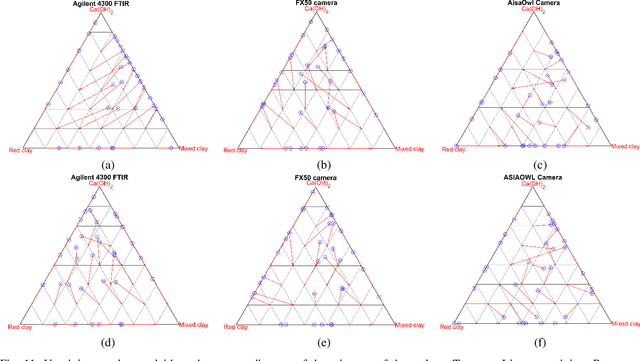
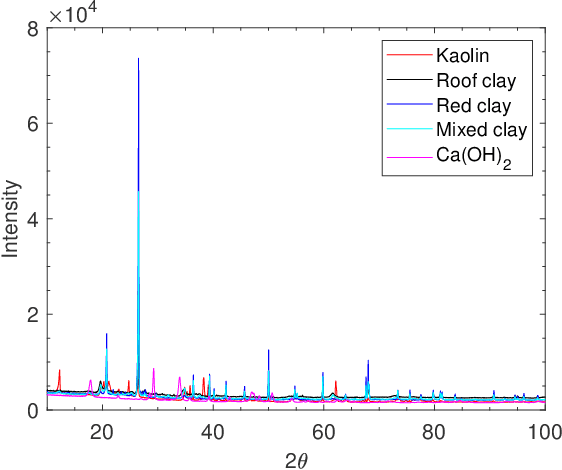
Abstract:Optical hyperspectral cameras capture the spectral reflectance of materials. Since many materials behave as heterogeneous intimate mixtures with which each photon interacts differently, the relationship between spectral reflectance and material composition is very complex. Quantitative validation of spectral unmixing algorithms requires high-quality ground truth fractional abundance data, which are very difficult to obtain. In this work, we generated a comprehensive laboratory ground truth dataset of intimately mixed mineral powders. For this, five clay powders (Kaolin, Roof clay, Red clay, mixed clay, and Calcium hydroxide) were mixed homogeneously to prepare 325 samples of 60 binary, 150 ternary, 100 quaternary, and 15 quinary mixtures. Thirteen different hyperspectral sensors have been used to acquire the reflectance spectra of these mixtures in the visible, near, short, mid, and long-wavelength infrared regions (350-15385) nm. {\color{black} Overlaps in wavelength regions due to the operational ranges of each sensor} and variations in acquisition conditions {\color{black} resulted in} a large amount of spectral variability. Ground truth composition is given by construction, but to verify that the generated samples are sufficiently homogeneous, XRD and XRF elemental analysis is performed. We believe these data will be beneficial for validating advanced methods for nonlinear unmixing and material composition estimation, including studying spectral variability and training supervised unmixing approaches. The datasets can be downloaded from the following link: https://github.com/VisionlabUA/Multisensor_datasets.
Image Processing and Machine Learning for Hyperspectral Unmixing: An Overview and the HySUPP Python Package
Aug 18, 2023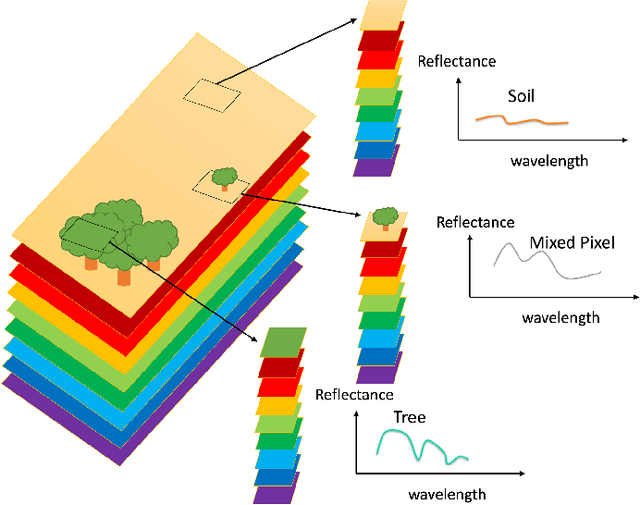

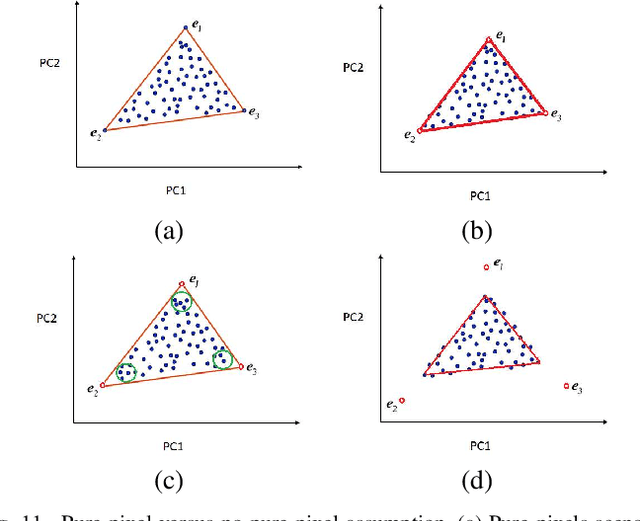
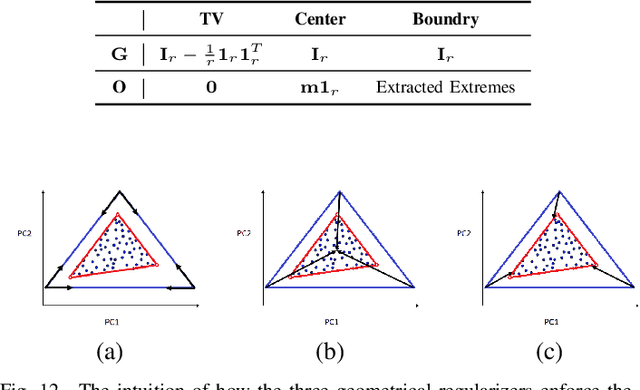
Abstract:Spectral pixels are often a mixture of the pure spectra of the materials, called endmembers, due to the low spatial resolution of hyperspectral sensors, double scattering, and intimate mixtures of materials in the scenes. Unmixing estimates the fractional abundances of the endmembers within the pixel. Depending on the prior knowledge of endmembers, linear unmixing can be divided into three main groups: supervised, semi-supervised, and unsupervised (blind) linear unmixing. Advances in Image processing and machine learning substantially affected unmixing. This paper provides an overview of advanced and conventional unmixing approaches. Additionally, we draw a critical comparison between advanced and conventional techniques from the three categories. We compare the performance of the unmixing techniques on three simulated and two real datasets. The experimental results reveal the advantages of different unmixing categories for different unmixing scenarios. Moreover, we provide an open-source Python-based package available at https://github.com/BehnoodRasti/HySUPP to reproduce the results.
SUnAA: Sparse Unmixing using Archetypal Analysis
Aug 09, 2023Abstract:This paper introduces a new sparse unmixing technique using archetypal analysis (SUnAA). First, we design a new model based on archetypal analysis. We assume that the endmembers of interest are a convex combination of endmembers provided by a spectral library and that the number of endmembers of interest is known. Then, we propose a minimization problem. Unlike most conventional sparse unmixing methods, here the minimization problem is non-convex. We minimize the optimization objective iteratively using an active set algorithm. Our method is robust to the initialization and only requires the number of endmembers of interest. SUnAA is evaluated using two simulated datasets for which results confirm its better performance over other conventional and advanced techniques in terms of signal-to-reconstruction error. SUnAA is also applied to Cuprite dataset and the results are compared visually with the available geological map provided for this dataset. The qualitative assessment demonstrates the successful estimation of the minerals abundances and significantly improves the detection of dominant minerals compared to the conventional regression-based sparse unmixing methods. The Python implementation of SUnAA can be found at: https://github.com/BehnoodRasti/SUnAA.
Entropic Descent Archetypal Analysis for Blind Hyperspectral Unmixing
Sep 26, 2022

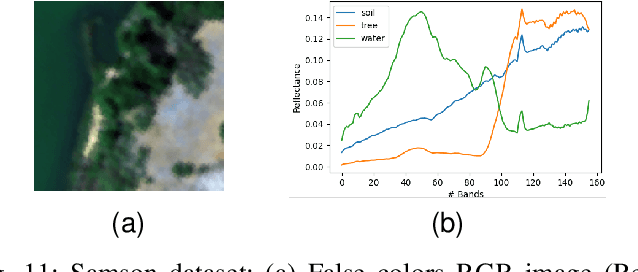
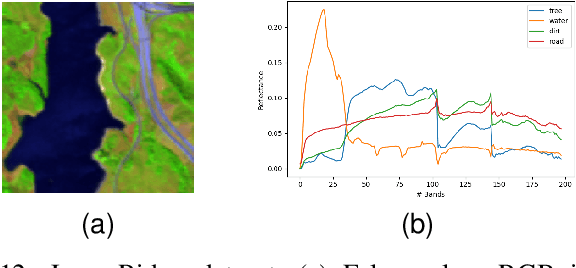
Abstract:In this paper, we introduce a new algorithm based on archetypal analysis for blind hyperspectral unmixing, assuming linear mixing of endmembers. Archetypal analysis is a natural formulation for this task. This method does not require the presence of pure pixels (i.e., pixels containing a single material) but instead represents endmembers as convex combinations of a few pixels present in the original hyperspectral image. Our approach leverages an entropic gradient descent strategy, which (i) provides better solutions for hyperspectral unmixing than traditional archetypal analysis algorithms, and (ii) leads to efficient GPU implementations. Since running a single instance of our algorithm is fast, we also propose an ensembling mechanism along with an appropriate model selection procedure that make our method robust to hyper-parameter choices while keeping the computational complexity reasonable. By using six standard real datasets, we show that our approach outperforms state-of-the-art matrix factorization and recent deep learning methods. We also provide an open-source PyTorch implementation: https://github.com/inria-thoth/EDAA.
 Add to Chrome
Add to Chrome Add to Firefox
Add to Firefox Add to Edge
Add to Edge